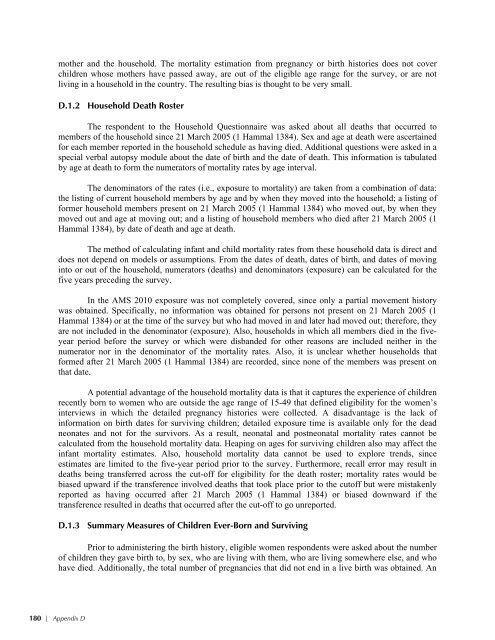Afghanistan Mortality Survey 2010 - Measure DHS
Afghanistan Mortality Survey 2010 - Measure DHS
Afghanistan Mortality Survey 2010 - Measure DHS
- No tags were found...
You also want an ePaper? Increase the reach of your titles
YUMPU automatically turns print PDFs into web optimized ePapers that Google loves.
mother and the household. The mortality estimation from pregnancy or birth histories does not coverchildren whose mothers have passed away, are out of the eligible age range for the survey, or are notliving in a household in the country. The resulting bias is thought to be very small.D.1.2 Household Death RosterThe respondent to the Household Questionnaire was asked about all deaths that occurred tomembers of the household since 21 March 2005 (1 Hammal 1384). Sex and age at death were ascertainedfor each member reported in the household schedule as having died. Additional questions were asked in aspecial verbal autopsy module about the date of birth and the date of death. This information is tabulatedby age at death to form the numerators of mortality rates by age interval.The denominators of the rates (i.e., exposure to mortality) are taken from a combination of data:the listing of current household members by age and by when they moved into the household; a listing offormer household members present on 21 March 2005 (1 Hammal 1384) who moved out, by when theymoved out and age at moving out; and a listing of household members who died after 21 March 2005 (1Hammal 1384), by date of death and age at death.The method of calculating infant and child mortality rates from these household data is direct anddoes not depend on models or assumptions. From the dates of death, dates of birth, and dates of movinginto or out of the household, numerators (deaths) and denominators (exposure) can be calculated for thefive years preceding the survey.In the AMS <strong>2010</strong> exposure was not completely covered, since only a partial movement historywas obtained. Specifically, no information was obtained for persons not present on 21 March 2005 (1Hammal 1384) or at the time of the survey but who had moved in and later had moved out; therefore, theyare not included in the denominator (exposure). Also, households in which all members died in the fiveyearperiod before the survey or which were disbanded for other reasons are included neither in thenumerator nor in the denominator of the mortality rates. Also, it is unclear whether households thatformed after 21 March 2005 (1 Hammal 1384) are recorded, since none of the members was present onthat date.A potential advantage of the household mortality data is that it captures the experience of childrenrecently born to women who are outside the age range of 15-49 that defined eligibility for the women’sinterviews in which the detailed pregnancy histories were collected. A disadvantage is the lack ofinformation on birth dates for surviving children; detailed exposure time is available only for the deadneonates and not for the survivors. As a result, neonatal and postneonatal mortality rates cannot becalculated from the household mortality data. Heaping on ages for surviving children also may affect theinfant mortality estimates. Also, household mortality data cannot be used to explore trends, sinceestimates are limited to the five-year period prior to the survey. Furthermore, recall error may result indeaths being transferred across the cut-off for eligibility for the death roster; mortality rates would bebiased upward if the transference involved deaths that took place prior to the cutoff but were mistakenlyreported as having occurred after 21 March 2005 (1 Hammal 1384) or biased downward if thetransference resulted in deaths that occurred after the cut-off to go unreported.D.1.3 Summary <strong>Measure</strong>s of Children Ever-Born and SurvivingPrior to administering the birth history, eligible women respondents were asked about the numberof children they gave birth to, by sex, who are living with them, who are living somewhere else, and whohave died. Additionally, the total number of pregnancies that did not end in a live birth was obtained. An180 | Appendix D








![Obtaining Informed Consent for HIV Testing [QRS4] - Measure DHS](https://img.yumpu.com/49850117/1/190x245/obtaining-informed-consent-for-hiv-testing-qrs4-measure-dhs.jpg?quality=85)








